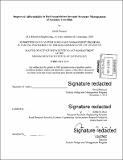Improved affordability in DoD acquisitions through strategic management of systemic cost risk
Author(s)
Petrucci, David J
DownloadFull printable version (12.62Mb)
Alternative title
Improved affordability in Department of Defense acquisitions through strategic management of systemic cost risk
Other Contributors
System Design and Management Program.
Advisor
Adam M. Ross.
Terms of use
Metadata
Show full item recordAbstract
For almost 70 years, actual costs of Major Defense Acquisition Programs (MDAPs) in the Department of Defense (DoD) have exceeded on average between 20% and 506% of their life cycle cost estimates, which are official expectations of actual program costs prior to completion. Despite numerous DoD acquisition reform efforts and implementation of sophisticated cost estimation techniques, this cost growth continues to exist. Accurate cost estimates are vital to the capital budgeting process for the DoD since they are used to set the affordability cap for each MDAP and across DoD Component weapon system program portfolios. Affordability is defined as the upper limit a DoD Component can allocate for a program without reducing costs or shifting resources between programs. To improve affordability in the DoD, a method that quantifies and adjusts for the persistent cost growth to enhance the accuracy of cost estimates is needed to promote more responsible and sustainable MDAP capital investment decisions. This thesis presents a simple yet powerful method of quantifying and correcting for systemic cost estimation risk in MDAPs to improve cost estimate accuracy and, consequently, affordability. Cost estimation risk is defined as the difference between estimated and actual MDAP costs (on average a deficit), and it consists of systemic and program-specific components. This dichotomized risk framework is similar to the one used in the Capital Asset Pricing Model (CAPM) in which the growth rate in value of any one of a set of assets comprising a market in equilibrium is proportional to its systemic risk exposure to that market. In the CAPM, systemic risk aggregated risk from multiple economic factors - pervades the market and is unavoidable, and asset-specific risk is considered unpredictable due to idiosyncratic uncertainties. By analogy, the growth rate in cost estimates for a program belonging to the "market" of MDAPs is assumed proportional to that MDAP's systemic risk exposure to the market. Like in CAPM, systemic cost estimation risk - aggregated risk from 26 systemic factors identified in this thesis - pervades the market for MDAPs, as evidenced by historical cost overruns, and program-specific cost risk is considered unpredictable and best mitigated by program-dedicated professional cost estimators in the DoD and defense industry. From this analogy, the expected growth-beta relationship of CAPM may be adapted to determine for MDAPs the systemic cost risk-adjusted growth rates for the defense commodity classes of aircraft, electronics and software, missiles, ships, space and satellites, and vehicles. These classes are the same used by the Bureau of Economic Analysis to segment defense commodities into distinct price index "baskets" based upon common inflation risks among commodities within each class. Based on this rationale, each MDAP is assumed to share systemic cost risk within its respective class; this risk is measured by beta in the expected growth-beta relationship. Defense commodity class beta values are calculated by linear regression of historical percentage cost estimate changes of member MDAPs with those of all MDAPs, and then averaging these beta values over the appropriate defense commodity class. Next, the expected cost estimate growth rate for any MDAP may be calculated by first estimating the future expected growth rate in all MDAPs using the arithmetic mean of historical annual cost estimate percentage changes, and then scaling this rate by the particular MDAP's systemic cost risk exposure - the defense commodity class beta value for which it is a member. Finally, the Systemic Risk Factor (SRF) for each defense commodity class is calculated from these growth rates and the forecast time horizon, adjusted for compounding effects over relatively longer time horizons, and then applied to current MDAP cost estimates to form systemic risk-adjusted cost estimates to improve affordability. This method was applied to an empirical retrospective case study using a set of cost data from six MDAPs, one from each commodity class, as a partial validation of the method. The results of this study show an overall 57% enhancement in estimation accuracy when comparing the initial and SRF-adjusted MDAP cost estimates to the final estimates, indicating quantifying and adjusting for systemic cost risk can improve cost estimation accuracy. To show the effectiveness of this method on improving affordability, these six programs were combined to form a hypothetical acquisition portfolio and assessed for affordability over a five year period. While the unadjusted portfolio was not affordable four out of five years, the SRF-adjusted portfolio was affordable in all but the last year, illustrating the benefit of adjusting cost estimates for systemic risk. However, the benefits of improved cost estimate accuracy and affordability come at the cost of potentially over-budgeting for priority MDAPs thereby leaving less funds available for other, lower priority programs. Additionally, this method is not shown to be optimal in the sense of minimizing cost estimate errors to maximize affordability. Still, empirical results are promising and warrant further research into the idea of using SRFs to adjust life cycle cost estimates and ultimately improve MDAP affordability for the DoD.
Description
Thesis: S.M. in Engineering and Management, Massachusetts Institute of Technology, Engineering Systems Division, System Design and Management Program, 2014. Cataloged from PDF version of thesis. Includes bibliographical references (pages 93-95).
Date issued
2014Department
System Design and Management Program.; Massachusetts Institute of Technology. Engineering Systems DivisionPublisher
Massachusetts Institute of Technology
Keywords
Engineering Systems Division., System Design and Management Program.